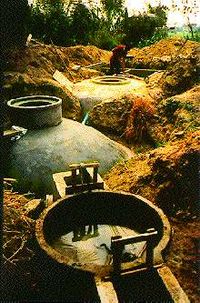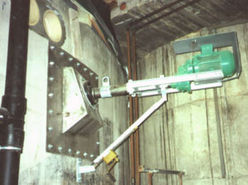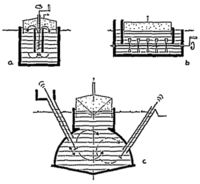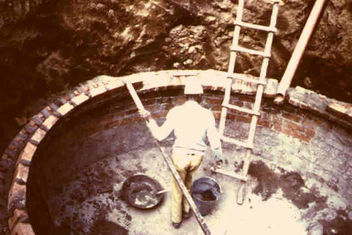Knowledge fuels change
For over a decade, Energypedia has shared free, reliable energy expertise with the world.
We’re now facing a serious funding gap.
Help keep this platform alive — your donation, big or small, truly matters!
Thank you for your support
Difference between revisions of "Parts of a Biogas Plant"
***** (***** | *****) m |
***** (***** | *****) m (→Biogas Piping) |
||
| Line 74: | Line 74: | ||
= Gas Pipe, Valves and Accessories<br/> = | = Gas Pipe, Valves and Accessories<br/> = | ||
| + | |||
== Biogas Piping<br/> == | == Biogas Piping<br/> == | ||
| Line 80: | Line 81: | ||
|- | |- | ||
| | | | ||
| − | [[File:Bgstirrer.jpg| | + | [[File:Bgstirrer.jpg|248px|RTENOTITLE]] |
<small class="IMGLEGEND">'''Stirring device for a european biodigester'''</small><ref name="Photo: Krieg">Photo: Krieg</ref> | <small class="IMGLEGEND">'''Stirring device for a european biodigester'''</small><ref name="Photo: Krieg">Photo: Krieg</ref> | ||
| Line 92: | Line 93: | ||
<br/> | <br/> | ||
| − | + | [[Gas_Pipe,_Valves_and_Accessories#Gas_Pipe|Read More here...]] | |
| + | |||
| + | == Water Traps == | ||
| + | |||
| + | [[Gas_Pipe,_Valves_and_Accessories#Water_traps|►]][[Gas_Pipe,_Valves_and_Accessories#Water_traps|Read more here....]] | ||
| + | |||
| + | == Valves == | ||
| − | + | [[Gas_Pipe,_Valves_and_Accessories#Valves|►]][[Gas_Pipe,_Valves_and_Accessories#Valves|Read more here...]] | |
| − | + | == Gas Analysis Equipment == | |
| − | + | ||
| − | + | [[Gas_Pipe,_Valves_and_Accessories#Gas_Analysis_Equipment|►]][[Gas_Pipe,_Valves_and_Accessories#Gas_Analysis_Equipment|Read more here...]] | |
| − | |||
| − | |||
= Stirring Facilities<br/> = | = Stirring Facilities<br/> = | ||
Revision as of 10:39, 20 March 2014
Overview
The feed material is mixed with water in the influent collecting tank The fermentation slurry flows through the inlet into the digester. The bacteria from the fermentation slurry are intended to produce biogas in the digester. For this purpose, they need time. Time to multiply and to spread throughout the slurry. The digester must be designed in a way that only fully digested slurry can leave it. The bacteria are distributed in the slurry by stirring (with a stick or stirring facilities). The fully digested slurry leaves the digester through the outlet into the slurry storage.The biogas is collected and stored until the time of consumption in the gasholder. The gas pipe carries the biogas to the place where it is consumed by gas appliances. Condensation collecting in the gas pipe is removed by a water trap.
Depending on the available building material and type of plant under construction, different variants of the individual components are possible. The following (optional) components of a biogas plant can also play an important role and are described seperatly: Heating systems, pumps, weak ring.
Influent Collecting Tank
|
Installation of a fixed-dome plant in Thailand: The influent collecting tank is in front of the photo, the digester and the outlet are located behind it.[1] |
Size and Homogenization
Fresh substrate is usually gathered in an influent collecting tank prior to being fed into the digester. Depending on the type of system, the tank should hold one to two days' substrate. An influent collecting tank can also be used to homogenize the various substrates and to set up the required consistency, e.g. by adding water to dilute the mixture of vegetable solids (straw, grass, etc.), or by adding more solids in order to increase the bio-mass. The fibrous material is raked off the surface, if necessary, and any stones or sand settling at the bottom are cleaned out after the slurry is admitted to the digester. The desired degree of homogenization and solids content can be achieved with the aid of an agitator, pump or chopper. A rock or wooden plug can be used to close off the inlet pipe during the mixing process.
Location
A sunny location can help to warm the contents before they are fed into the digester in order to avoid thermal shock due to the cold mixing water. In the case of a biogas plant that is directly connected to the stable, it is advisable to install the mixing pit deep enough to allow installation of a floating gutter leading directly into the pit. Care must also be taken to ensure that the low position of the mixing pit does not result in premature digestion. For reasons of hygiene, toilets should have a direct connection to the inlet pipe.
Inlet and Outlet
The inlet (feed) and outlet (discharge) pipes lead straight into the digester at a steep angle. For liquid substrate, the pipe diameter should be 10-15 cm, while fibrous substrate requires a diameter of 20-30 cm. The inlet and the outlet pipe mostly consist of plastic or concrete.
Position
Both the inlet and the outlet pipe must be freely accessible and straight, so that a rod can be pushed through to eliminate obstructions and agitate the digester contents. The pipes should penetrate the digester wall at a point below the lowest slurry level (i.e. not through the gas storage). The points of penetration should be sealed and reinforced with mortar.
The inlet pipe ends higher in the digester than the outlet pipe in order to promote more uniform flow of the substrate. In a fixed-dome plant, the inlet pipe defines the bottom line of the gas-holder, acting like a security valve to release over-pressure. In a floating-drum plant, the end of the outlet pipe determines the digester's (constant) slurry level.
Inlet and outlet pipe must be placed in connection with brick-laying. It is not advisable to break holes into the spherical shell afterwards, this would weaken the masonry structure.
Toilet Connection at the Inlet
--> Household Toilets can be connected to a Biogas Digester.
Digester
In general terms, digesters consist of the digestion tank as such, which is thermally insulated, plus a heating system, mixer systems and discharge systems for sediments and the spent substrate
Raw Material for Biogas Digesters
Types of Biogas Digesters
Types of Gasholders for Biogas Plants
Gas Pipe, Valves and Accessories
Biogas Piping
|
Stirring device for a european biodigester[2] |
At least 60% of all non-functional biogas units are attributable to defect gas piping. Utmost care has to be taken, therefore, for proper installation. For the sake of standardization, it is advisable to select a single size for all pipes, valves and accessories.
The requirements for biogas piping, valves and accessories are essentially the same as for other gas installations. However, biogas is 100% saturated with water vapor and contains hydrogen-sulfide. Consequently, no piping, valves or accessories that contain any amounts of ferrous metals may be used for biogas piping, because they would be destroyed by corrosion within a short time. The gas lines may consist of standard galvanized steel pipes. Also suitable (and inexpensive) is plastic tubing made of rigid PVC or rigid PE. Flexible gas pipes laid in the open must be UV-resistant.
Water Traps
Valves
Gas Analysis Equipment
Stirring Facilities
|
Stirring facilities in the digester[3] |
Optimum stirring substantially reduces the retention time. If agitation is excessive, the bacteria have "no time to eat". The ideal is gentle but intensive stirring about every four hours. Of similar importance is the breaking up of a scum layer which has lost contact with the main volume of substrate and is, therefore, not further digested. This top layer can form an impermeable barrier for biogas to move up from the digester to the gas holder.
As a rule of thumb it can be stated that stirring facilities are more important in larger plants than in small scale farm plants.
Types of Stirring Facilities
- The impeller stirrer has given good results especially in sewage treatment plants.
- The horizontal shaft stirs the fermentation channel without mixing up the phases. Both schemes originate from large-scale plant practice.
- For simple household plants, poking with a stick is the simplest and safest stirring method.
Heating Systems
Normally, because of the rather high involved costs, small-scale biogas plants are built without heating systems. But even for small scale plants, it is of advantage for the bio-methanation process to warm up the influent substrate to its proper process temperature before it is fed into the digester. If possible, cold zones in the digester should be avoided (see also substrate temperature).
In the following, a number of different ways to get the required amount of thermal energy into the substrate are described.
In principle, one can differentiate between:
- direct heating in the form of steam or hot water, and
- indirect heating via heat exchanger, whereby the heating medium, usually hot water, imparts heat while not mixing with the substrate.
Pumps
Pumps become necessary parts of a biogas unit, when the amounts of substrate require fast movement and when gravity cannot be used for reasons of topography or substrate characteristics. Pumps transport the substrate from the point of delivery through all the stages of fermentation. Therefore, several pumps and types of pumps may be needed. Pumps are usually found in large scale biogas units.
Types of Pumps
Weak Ring
The weak/strong ring improves the gas-tightness of fixed-dome plants It was first introduced in Tanzania and showed promising results. The weak ring separates the lower part of the hemispherical digester, (filled with digesting substrate), from the upper part (where the gas is stored). Vertical cracks, moving upwards from the bottom of the digester, are diverted in this ring of lean mortar into horizontal cracks. These cracks remain in the slurry area where they are of no harm to the gas-tightness. The strong ring is a reinforcement of the bottom of the gas-holder, it could also be seen as a foundation of the gas-holder. It is an additional device to prevent cracks from entering the gas-holder. Weak and strong ring have been successfully combined in the CAMARTEC design
| Photo[4]: Construction of the weak/strong ring of a 16 m3, Tanzania |
Materials and Construction
The weak ring consists of mortar of a mixture of sand, lime and cement (15:3:1). The top of the weak ring restores the horizontal level. It is interrupted only by the inlet pipe passing through. The strong ring rests on the weak ring and is the first layer of the upper part of the hemispherical shell. It consists of a row of header bricks with a concrete package at the outside. In case of soft or uncertain ground soil one may place a ring reinforcement bar in the concrete of the strong ring. The brick of the strong ring should be about three times wider than the brickwork of the upper wall. A detailed description of the weak/strong ring construction can be found in Sasse, Kellner, Kimaro (1991).
Pre-digestion pit for storage of substrates
Sizing depends on:
substrate arisings, digester capacity, length of time to be bridged between successive deliveries, land-use specifics and yield of co-substrates, supply contracts for substrates from off-site sources, possible disruptions in operation
Special considerations:
- Avoid the possibility of storage plant freezing, for example by siting storage tanks indoors, heating storage containers or locating the plant for pits below grade level
- Avoid biodegradation processes that reduce gas yield
- Do not permit intermingling of hygienically problematic and hygienically acceptable substrates
- Implement suitable structural measures to minimise odours
- Avoid material emissions to soil and to the surface and underground water system
Designs
Containers for storing solid substrates in widespread use in agriculture, such as mobile silos, upright silos, plastic-tunnel silos and round-bale silos and open or roofed storage areas (e.g. solid-manure deposits) and pits/hoppers
Containers for storing liquid substrates in widespread use in agriculture, such as tanks and predigester pits
Costs
Storage facilities are generally in place; when new builds are needed the price has to be calculated on
a case-to-case basis factoring in the multiplicity of influencing variables indicated above
Measurement instruments
Flow-measuring devices (in the pipes)
Ultrasonically (pre pits)
Radar (pre-pits)
Wheel loader scales
Volume flow
Piping
The piping system connects the biogas plant with the biogas appliances. It has to be safe, economic and should allow the required gas-flow for the specific gas appliance. Galvanized steel (G.I.) pipes or Polyvinyl chloride (PVC) pipes are most commonly used for this purpose. Most prominently, the piping system has to be reliably gas-tight during the life-span of the biogas unit. In the past, faulty piping systems were the most frequent reason for gas losses in biogas units.
Polyvinyl chloride (PVC) piping
Polyvinyl chloride (PVC) pipes and fittings have a relatively low price and can be easily installed. They are available in different qualities with adhesive joints or screw couplings (pressure water pipes). PVC pipes are susceptible to UV radiation and can easily be damaged by playing children. Wherever possible, PVC pipes should be placed underground.
Galvanized Steel Piping
Galvanized steel (G.I.) pipes are reliable and durable alternatives to PVC pipes. They can be disconnected and reused if necessary. They resist shocks and other mechanical impacts. However, galvanized steel pipes are costly and the installation is labor intensive, therefore they are only suitable for places where PVC is unavailable or should not be used.
Pipe Diameters
The necessary pipe diameter depends on the required flow-rate of biogas through the pipe and the distance between biogas digester and gas appliances. Long distances and high flow-rates lead to a decrease of the gas pressure. The longer the distance and the higher the flow rate, the higher the pressure drops due to friction. Bends and fittings increase the pressure losses. G.I. pipes show higher pressure losses than PVC pipes. Table 1 gives some values for appropriate pipe diameters. Using these pipe diameters for the specified length and flow rate, the pressure losses will not exceed 5 mbar.
| Galvanized steel pipe | PVC pipe | |||||
|---|---|---|---|---|---|---|
| Length [m]: | 20 | 60 | 100 | 20 | 60 | 100 |
| Flow-rate [m3/h] | ||||||
| 0.1 | 1/2" | 1/2" | 1/2" | 1/2" | 1/2" | 1/2" |
| 0.2 |
1/2" | 1/2" | 1/2" | 1/2" | 1/2" | 1/2" |
| 0.3 | 1/2" | 1/2" | 1/2" | 1/2" | 1/2" | 1/2" |
| 0.4 | 1/2" | 1/2" | 1/2" | 1/2" | 1/2" | 1/2" |
| 0.5 | 1/2" | 1/2" | 3/4" | 1/2" | 1/2" | 1/2" |
| 1.0 | 3/4" | 3/4" | 3/4" | 1/2" | 3/4" | 3/4" |
| 1.5 | 3/4" | 3/4" | 1" | 1/2" | 3/4" | 3/4" |
| 2.0 |
3/4" | 1" | 1" | 3/4" | 3/4" | 1" |
The values in table 1 show that a pipe diameter of 3/4" is suitable for flow rates up to 1.5 m3/h and distances up to 100 m (PVC pipe). Therefore one could select the diameter of 3/4" as single size for the hole piping system of small biogas plants. Another option is to select the diameter of l" for the main gas pipe and 1/2" for all distribution pipes to the gas appliances.
Lay-out of the Piping System
PVC can be used for all underground pipes or pipes that are protected against sun light and out of the reach of children. For all parts of the piping system that are above ground one should install galvanized steel pipes. Therefore it is recommended to use l" G.I. steel pipes for the visible part of the piping system around the biogas digester. For the main pipe one uses l" PVC pipe placed underground. The distribution pipes should be 1/2" G.I. steel pipes or PVC pipes, depending whether they are installed above or under the wall plastering. But even though G.I. pipes are less susceptible to damage, placing them underground should always be the preferred solution.
PVC pipes have to be laid at least 25 cm deep underground. They should be placed in a sand bed and be covered with sand or fine earth. One should carefully back-fill the ditches in order to avoid stones lying directly above the pipe.
When the piping is installed - and before refilling the ditches - it has to be tested for possible gas leakage. This can be done by pumping air into the closed piping system up to a pressure that is 2.5 times the maximum gas pressure of the biogas plant. If pressure loss occurs within few hours, every joint of the piping system has to be checked with soap water. Soap-bubbles indicate any leakage of gas [5].
The valves, fittings and piping must be mediumproof and corrosion-resistant. Valves and fittings such as couplers, shut-off gate valves, flap traps, cleaning ports and pressure gauges must be readily accessible and operable and they must also be installed
in such a way as to be safe from frost damage. The 'Sicherheitsregeln für Biogasanlagen' (Safety Rules for Biogas Systems) issued by the Bundesverband der landwirtschaftlichen Berufsgenossenschaften (German Agricultural Occupational Health and
Safety Agency) contain information about the regulations for piping, valves and fittings and can be of assistance in achieving compliance with the laws and engineering codes with regard to material properties, safety precautions and leak tests for safe operation of the biogas plant [3-18]. One factor that has proved extremely important is the necessity of providing suitable
means of removing condensate from all piping runs, without exception, or of running the pipes with enough fall to ensure that slight settling or sag cannot produce unintended high points along the runs. On account of the low pressures in the system, very small
quantities of condensate can suffice to cause a complete blockage [6].
Water traps
Due to temperature changes, the moisture-saturated biogas will form inevitably condensation water in the piping system. Ideally, the piping system should be laid out in a way that allows a free flow of condensation water back into the digester. If depressions in the piping system can not be avoided, one or several water traps have to be installed at the lowest point of the depressions. Inclination should not be less than 1%.
Often, water traps cannot be avoided. One has to decide then, if an 'automatic' trap or a manually operated trap is more suitable. Automatic traps have the advantage that emptying - which is easily forgotten - is not necessary. But if they dry up or blow empty, they may cause heavy and extended gas losses. In addition, they are not easily understood. Manual traps are simple and easy to understand, but if they are not emptied regularly, the accumulated condensation water will eventually block the piping system. Both kinds of traps have to be installed in a solid chamber, covered by a lid to prevent an eventual filling up by soil [7].
Valves
To the extent possible, ball valves or cock valves suitable for gas installations should be used as shutoff and isolating elements. The most reliable valves are chrome-plated ball valves. Gate valves of the type normally used for water pipes are not suitable. Any water valves exceptionally used must first be checked for gas-tightness. They have to be greased regularly. A U-tube pressure gauge is quick and easy to make and can normally be expected to meet the requirements of a biogas plant.
The main gas valve has to be installed close to the biogas digester. Sealed T-joints should be connected before and after the main valve. With these T-joints it is possible to test the digester and the piping system separately for their gas-tightness. Ball valves as shutoff devices should be installed at all gas appliances. With shutoff valves, cleaning and maintenance work can be carried out without closing the main gas valve.
Gas Analysis Equipment
Sensors
Sensors in the gas space must satisfy explosion protection requirements and should be resistant to corrosion and high levels of moisture.
- Infrared sensors
- Thermal conductivity sensors
The sensors used to measure the temperature should be installed at various heights so that stratification and inadequate mixing can be detected. Care should also be taken that the sensors are not installed in dead zones or too close to the temperature stabilisation equipment. Resistance sensors (e.g. PT 1000 or PT 100) or thermocouples are suitable for measuring the temperature.
- Electrochemical sensors
- Paramagnetic sensors
- Inductive and capacitive sensors
BiogasBox
Documents on the contruction of biogas plants.
Web
http://biogas.ifas.ufl.edu/ad_development/documents/biogasplants.pdf
https://energypedia.info/index.php/Construction_of_a_Biogas_Plant
http://www.haase-energietechnik.de/en/Products_and_Services/24-e_BiogasBrochure_Feb2011_1.pdf
References
- Ringkamp, M.; Tentscher, W.; Schiller, H.: Preliminary results on: statical optimization of family-sized fixed-dome digesters. Tilche, A.; Rozzi, A. (ed.): Poster Papers. Fifth International Symposium on Anaerobic Digestion, Bologna 1988, pp. 321-324
- Sasse, L.; Kellner, Ch.; Kimaro, A.: Improved Biogas Unit for Developing Countries. Deutsche Gesellschaft für Technische Zusammenarbeit (GTZ) GmbH, Vieweg & Sohn Verlagsgesellschaft Braunschweig, 1991
- J.; Sasse, L. (Deutsche Gesellschaft für Technische Zusammenarbeit): Production and utilization of biogas in rural areas of industrialized and developing countries. TZ-Verlagsgesellschaft mbH, Roßdorf, 1986, 278 S.</span>
This section provides detailed information on materials and devices used in the construction of biogas plants:























